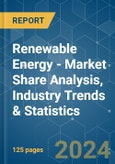The Renewable Energy Market size is estimated at 4.24 terawatt in 2024, and is expected to reach 5.98 terawatt by 2029, growing at a CAGR of 7.09% during the forecast period (2024-2029).
The market was negatively impacted by COVID-19 in 2020. Presently the market has now reached pre-pandemic levels.
This product will be delivered within 2 business days.
The market was negatively impacted by COVID-19 in 2020. Presently the market has now reached pre-pandemic levels.
Key Highlights
- Over the long term, the major driving factors of the market are the favorable government policies, increasing adoption of renewable energy with the declining price of solar panels and wind turbines installations.
- On the flip side, the rising adoption of alternate clean power sources, such as gas-fired power plants and nuclear energy projects are likely to slow down the market growth.
- Technological advancements in solar PV manufacturing and solving intermittency problems using energy storage systems are likely to provide huge opportunities for the market studied.
- Asia-Pacific is expected to be the fastest-growing market during the forecast period, with the majority of the demand coming from China and India.
Renewable Energy Market Trends
Hydropower Segment to Dominate the Market
- Hydroelectric power (hydropower) is a renewable energy source where electrical power is derived from the energy of water moving from higher to lower elevations. Hydropower projects also supply clean water for agriculture, homes, and business and help mitigate the impacts of extreme weather events, such as floods and drought.
- Hydropower is the single largest source of renewable electricity globally. In 2022, renewable electricity generation from hydropower accounted for nearly 41% of total renewable energy, the largest contribution from hydropower in global renewable-based electricity generation.
- According to International Renewable Energy Agency, in 2022, the global hydropower installed capacity reached 1393 gigawatts (GW), representing a rise of 2.19% compared to 2021. The hydropower installed capacity is expected to grow with the upcoming hydro projects and technological advancements.
- In August 2022, Natel Energy, created by MIT alumni siblings, is developing hydropower systems that include fish-safe turbines and other features that imitate natural river conditions. Thus, with such kind of eco-friendly developments, the hydropower segment's demand is expected to increase in the forecast period.
- Moreover, in August 2022, the Government of India announced the development of two hydropower projects in Nepal, namely the West Seti Hydropower Project and the Seti River Hydropower Project. The total cost of these projects is expected to be around USD 2.4 billion.
- Thus, the hydropower segment is ecpected to dominate the market during the forecast period.
Asia-Pacific to Dominate the Market
- The Asia-Pacific region dominated the renewable energy market in recent years. It is likely to maintain its dominance during the forecast period.
- As of 2022, China is the global leader in renewable energy deployment. The country's total renewable energy capacity reached 1160.8 GW in 2022, representing an increase of approximately 13.4% compared to the previous year. Hydropower, solar, and wind are the major renewable energy sources in the country.
- India's power demand increased significantly in line with its expanding economy and growing population. In 2022, the country generated 162.96 GW of hydropower, up from 147.12 GW in 2021.
- Also, India has become the world's third-largest power consumer after China and the United States. Further, India's net power generation capacity increased significantly in the last decade, most of which came from renewable energy sources, including large hydro.
- The Government of India has set a target of installing 175 GW of renewable energy capacity by FY 2022, including 100 GW from solar, 60 GW from wind, 10 GW from bio-power, and 5 GW from small hydro-power. Moreover, the Indian Ministry for New and Renewable Energy expects investment of USD 15 billion in renewable energy, electric vehicles, manufacturing of solar equipment, and green hydrogen in 2022.
- Moreover, In January 2022, SJVN (Satluj Jal Vidyut Nigam Ltd) bagged a solar project of 125 MW in Uttar Pradesh through a bidding process held by the Uttar Pradesh New and Renewable Energy Development Agency (UPNEDA). It includes a 75 MW grid-connected solar project in Jalaun and a 50 MW solar project in Kanpur Dehat districts.
- Japan's government has also targeted reducing carbon emissions to 50% by 2030 and achieving carbon neutrality by 2050. In September 2022, Green Power Investment (GPI) chose GE Renewable Energy as the provider for the Fukaura Wind Farm in Fukaura Town, Nishi Tsugaru District, Aomori Prefecture, Japan. The project, which will include 19 units of GE's 4.2-117 onshore wind turbines, is GE's third in Japan.
- Hence, such developments will likely make Asia-Pacific dominant in the renewable energy market during the forecast period.
Renewable Energy Industry Overview
The renewable energy market is fragmented in nature. Some of the major players in the market (in no particular order) include First Solar Inc., Vestas Wind Systems A/S, Canadian Solar Inc., Jinko Solar Holding Co. Ltd, and General Electric Company.Additional Benefits:
- The market estimate (ME) sheet in Excel format
- 3 months of analyst support
This product will be delivered within 2 business days.
Table of Contents
1 INTRODUCTION
4 MARKET OVERVIEW
5 MARKET SEGMENTATION
6 COMPETITIVE LANDSCAPE
7 MARKET OPPORTUNITIES AND FUTURE TRENDS
Companies Mentioned (Partial List)
A selection of companies mentioned in this report includes, but is not limited to:
- EPC Developers/Operators/Owners
- Equipment Suppliers
Methodology

LOADING...










